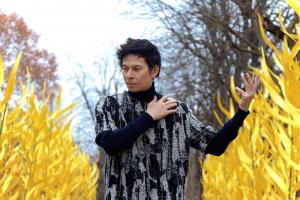Éric MINH CUONG CASTAING
Choreographer, visual artist
Eric received a production grant for his show Forme(s) de Vie.
What is your artistic background ?
I was born in Villepinte, Seine-Saint-Denis. I started doing hip-hop there, in high school. I became interested in real-time writing, and I explored contemporary dance, particularly Japanese Butô. At the same time, I was already drawing a lot, everywhere; I entered Les Gobelins (the school of images, in Paris), then I worked for several years as a graphic designer in animated films. To deepen an approach to movement through both dance and image, I founded my own company, Shonen ("teenager", in Japanese) in 2008, which carries choreographic creation through a plurality of mediums, producing shows and performances, but also films and installations. I present the latter both in the field of dance and visual art, linking dance and new technologies (humanoid robots, drones, augmented reality...) into the framework of "in socius" creation processes, which take shape within societal realities in partnership with institutions (research laboratories, palliative care centres, NGOs...) outside the art world. Today, as an artist associated with the Ballet National de Marseille (2016-2019) and the Comédie de Valence (2020-2024), I try to confront my choreographic work with the world as it is: to technological issues because they open up a very rich imaginary world of anticipation, whereas in the present they shift our perceptions and our modes of relation without us realizing it; to a diversity of bodies (professional and amateur dancers) because this diversity shifts "dance" (which I perceive as an art of relation) on form and substance.
How do you see your profession today ?
There is a growing and widespread awareness that the professions in the art world are not exempt from the system, that they contribute to it. Neo-liberalism is playing its full part in this sector, whether private or institutional. There is a lot of superficiality in the way artists are fêted, but also in the works they make. We are in the era of elements of language, sometimes totally out of step with the reality of the works: it is the marketing of art which, in order to convince the market, must be embodied in the figure of the Artist with a capital "A", or those capable of imposing a legible and attractive "identity" with a great deal of Instagram reinforcement, etc. Art is a space of power where categories, mimicry and conservatism are prevalent: we will agree that the fact that an artist allows himself to tape a banana to the wall in order to sell it for XX dollars on the art market is indicative of the alienation of the system, but who dares to denounce the fact that so many leading artists have been content to recycle the same gestures for decades? This criticism can be constructive: we must shift our gaze to the works, to their issues and content, to the artistic processes, to the contexts of production. This would make it possible to avoid being mystified by the effects of discourse.
How do you see yourself in 5 years ? In 10 years ?
Above all, I image acts, places that are necessary for experimental creation to take place. I hope to work in a space-time where the question of dance would be the broader question of the body in movement, where the hybridity of artistic practices would no longer be an objective to be reached but an achievement, where the work would no longer be essentialized with regard to the origin, the first history or the career of an artist, where the ethical issue of the representation of fragile, hidden, discriminated bodies would be obvious, lived as a source of energy necessary to the renewal of scenic, visual and relational forms. I see myself in a place which speaks of the complexity of beings and which assumes, as a constructive, social and political force, that the question posed by dance is that of the relationship between living bodies. And, if this place does not exist, I hope, with others, to be able to create it.
Interview conducted in 2020
Photo credit : Kamila K. Stanley


